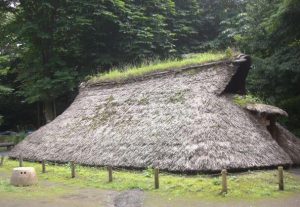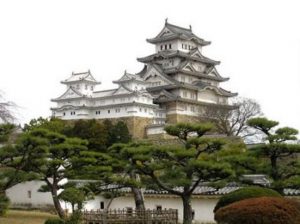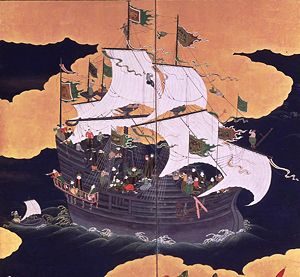The Japanese people are acutely aware of their historical past. Japanese culture is characterized by a preference for inner grace, as opposed to external splendor. Let’s dive into the origins and development of the ancient Japanese civilization and culture.

Ancient Japanese Civilization
Contents
Beginnings of the Japanese Civilization
Early Japan bore witness to rural rice settlements, loyalty to a centralist court, as well as the expansion of Kyoto, its ancient capital.
The land that makes up the current Japanese archipelago has been inhabited for at least 30,000 years, and possibly even as many as 200,000 years. The relatively shallow seas that separate Japan from continental Asia were not even entirely formed when the first human beings settled in the area. However, after the arrival of man, sea levels rose and ended up covering the former land bridges that joined Japan with the continent. Whether modern day Japanese people are the descendants of these first settlers or not remains a controversial question. Up until the 1960s, the country’s archaeological sites had not been extensively studied, which is why knowing the origins of the first settlers has not yet been possible. Even so, the theory that they came from the northern region of the Asian continent is commonly accepted, with these migrations happening over a long period of time.
Jomon period (ca. 10,000 – 300 BC)
The first millennium of the Neolithic period coincided with a global climatic warming that reached its peak between the years 8000 and 4000 BC. In Japan, this led to the rise in sea levels that covered the last land bridges connecting the island with the Asian continent, as well as the enrichment of marine fauna and the growth of new forests. This was the setting in which the Jomon period flourished in its early stages. The earliest pieces of pottery known in Japan date back to 10,000 BC and some experts claim they could be the oldest in the world.

At the beginning of this period, the population was nomadic and hunter-gathering for the most part and located in coastal regions. The abundance of fish, bivalves and marine mammals in their diet led to huge mounds of seafood shells, which are the first source of archaeological information about these people. They also hunted deer and wild boar and had cutting tools made of stone, as well as pieces of corded pottery (in fact, jomon means “a straw-rope pattern”).
Settlements moved inland in the middle of the Jomon period (ca. 3500 BC – 2000 BC). In this era, a decline in sea levels may have decimated marine fauna or increased confidence in agriculture as a source of food; this seems to be implied by the abundance of grindstones, lidded earthenware jars, and other objects related to cultivation. This intermediate stage came to an end when the interior regions’ harvests failed to provide enough food.
The late Jomon period, which began at around 2000 BC, is marked by the resurgence of fishing in the Pacific coastal region.
Yayoi period (ca. 300 BC – 300 AD)
This period, which is named after an archaeological site near the University of Tokyo, is characterized by a marked cultural transition driven by migrations from the rice-cultivating regions of Asia.
Coming from Korea and, with all possibility, from Okinawa, immigration took place across northern Kyushu from around 300 BC, and in under 600 years, the hunter-gatherer communities of Japan drifted towards a sedentary society based on the cultivation of rice. The growth of these autonomous but closely related settlements was so rapid in Kyushu, the archipelago’s southernmost island, and western Honshu that by about 100 AD, only northern Honshu and the island of Hokkaido were left out of this new development.
Kofun period (ca. 300 – 710)

The construction of large funerary tombs made from earth and stone in some coastal areas of Kyushu and along the whole coast of the Inner Sea marked the end of the Yayoi culture. These tombs were decorated with human figures and animals made of hollow clay, called haniwa, as well as scale models of houses that possibly represented the belongings of deceased leaders.
There was a rapid development of political and social institutions. The various population centers called themselves “countries” or “kingdoms” and had a characteristic social hierarchy, subject to the growing political influence of the Yamato plain region, in which Osaka and Nara are located today. The imperial dynasty, also called the Yamato dynasty, was almost certainly established by the most powerful family clans (uji) that had already formed at the end of the Yayoi period. Buddhism entered Japan in the 6th century through Korea, and although it is claimed that writing came with religion, Chinese writing is likely to have preceded Buddhism by around 100 or 150 years. In any case, writing gave the nobility access to religion, as well as Chinese classics and the doctrines of sages like Confucius. Literacy prompted notable political and social changes.
The power of one of the clans, the Soga, was accentuated by its exclusive control over the imperial treasury and grain reserves, as well as its monopolistic role as the patron of new knowledge from the continent.
Its consolidation as a political power was consummated with a new monopoly: only the daughters of the Soga clan were eligible as imperial consorts. This allowed family members to seize key positions in court. The reforms promoted with the aim of strengthening central power covered aspects such as social structure, economic and legal systems, territorial distribution of provinces, general administration, and taxation.
Nara period (710 – 794)

In the place where Nara is today, an empress from the early 8th century built a new capital, located in the northwest of the Yamato plain, which she called Heijo-kyo. The one hundred years or so following this milestone (the Nara period) saw the complete consolidation of the centralist imperial system, based on Chinese concepts (the Ritsuryo system), as well as the blossoming of art and culture.
With the application of the Ritsuryo system, the imperial government held strict administrative control through a powerful office that claimed all land dedicated to rice cultivation as imperial property. This led to a heavy tax burden on farmers.
Heian period (794 – 1185)
The capital was relocated again in the last decade of the 8th century. The new city was built according to Chinese urban patterns, as was typical, and was given the name Heian-kyo. It was the nucleus around which the city of Kyoto developed, and its completion in 795 marked the beginning of the Heian period’s four magnificent centuries. Kyoto was the imperial capital until 1868 when the court moved to the city Edo, which was later called Tokyo.
The power of the centralist regime lasted for several decades, but by the end of the 9th century, the Ritsuryo system began to collapse. The bureaucratic system allowed aristocrats and lords of the most important temples to accumulate great estates (shoen), while the farmers, burdened by the heavy taxes, fled to these favorable areas in great waves.
The court neglected the provinces as regional administrators were more concerned with personal enrichment than restoring order, which led to banditry. Landowners continued to accumulate power and ended up engaging in political struggles that put a drastic end to the Heian period.
Kamakura period (1185 – 1333)
The victor in these fights, Minamoto Yoritomo, received the title of shogun and established his court in Kamakura, far from Kyoto and a little to the south of the area where Edo would develop. There he built his headquarters and a new administrative structure that he hoped would bring the samurai under his rule. He established his dominion over the country through control over justice, the succession of the imperial throne, and the army.

Yorimoto persuaded the emperor to allow him to appoint provincial military posts, such as the shugo (military governors) and the jito (stewards), who were responsible for collecting taxes and managing the land. Both classes answered directly to the shogun, which is why a governmental system was created far from the capital based on the superiority of the military class, as well as on vassalage and dependence. It was not a very different regime from those of medieval Europe and one can consider the shogunate, or bakufu, to be completely feudal.
Consequently, the imperial court was left marginalized and neglected; it remained active but very weak. Until the emperor regained power in 1868, he played a ritual and symbolic role.
Although the Kamakura period was rather brief, the events that took place within it profoundly affected the development of the country; revolutionary advances in agricultural techniques allowed for an increase in food production, with subsequent economic and population growth. Sedentism and trade led to the emergence of local markets and a monetary system that encouraged new contact with China in the private sector. Some great leaders embraced Buddhism and asked for both the samurai class and the common people to follow their example, meaning that this religion ceased to be an aristocratic faith and it gained new followers.
However, the complexity of the civilian government system caused the system of governors and stewards to collapse. The fatigue caused by the country’s defense against two Mongolian invasions in 1274 and 1281, which were partly unsuccessful due to the fortuitous appearance of typhoons that destroyed the invading fleets, should also be noted.
Muromachi period (1333 -1568)

Shogun Ashikaga Takauji made Kyoto the capital once again and caused the shogunate to eclipse all remnants of political or economic power that the imperial court had preserved. In turn, Ashikaga, in the manner of the ancient nobility, devoted himself to cultural patronage and social relations. The Muromachi period is named after the area in Kyoto where a later shogun of the Ashikaga dynasty (Yoshimitsu) built his residence, which was when the power of the Ashikaga shogunate reached its zenith. Yoshimitsu played an active role in palace politics, while his military merits shone.
In short, the Muromachi period introduced the basic changes that would ensure the stability and economic growth of the following era: the Edo period. Agriculture improved, irrigation and new crops were introduced, commercial agriculture increased, skilled artisans emerged, the monetary economy expanded, while more importantly, most towns and cities grew, and with them, new mercantile and servile social classes developed.
After the assassination of one of the Ashikaga shoguns in 1441, the decline of the shogunate began. The breakup of the provinces’ military governors caused a decade of wars and widespread unrest that eroded central authority and cracked social structure; it was the prelude to the Warring States period (a century of struggles that spanned from 1467 to 1568).
The decentralization that occurred during this period led to the daimyo, fully feudal figures and lords who acquired their rank by right of conquest and military supremacy. It is not surprising that during this century of war, dominated by an ethic of military expansion, the most skilled and ambitious leaders dreamed of unifying the country.
Momoyama period (1568 – 1600)

In a certain way, this brief historical period is something of a historiographic artifice, as it is really the natural culmination of the Muromachi period. However, the so-called Momoyama period typically starts it in 1573 with the end of the Ashikaga shogunate, as well as the invasion of Kyoto by Oda Nobunaga (1534 – 1582), the first of the three great leaders who attempted to reunify the country. The other two were Toyotomi Hideyoshi (1536-1598) and Tokugawa Ieyasu (1542-1616).
Nobunaga conquered the provinces near his homeland in a methodical way, eliminated his rivals with his typical military efficacy and, despite being famous for razing the temples of the most belligerent sects around Kyoto, showed a certain “weakness” for culture. He managed to subdue a third of the country, although he was treasonously murdered by a general in 1582.
Hideyoshi, the head of Nobunaga’s Chief of Staff, executed his lord’s assassin and proclaimed himself to be his successor. With his great military talent and political gifts, as well as his rather large wealth, he boldly set out to reunify the country.
By 1590, almost all of Japan’s territories were directly or indirectly under his authority, but his government suffered from a lack of centralization, and was dispersed over a complex network of feudal relations, meaning his control of the country, which based on short-lived oaths of fealty, was shaky at best. Even so, he managed to impose major reforms, such as possibly the most impactful reform in Japanese history: the “sword hunt”, a law that stated that only samurai could possess swords. Even today, Japanese legislation on the possession of weapons, whether they’re melee weapons, firearms or otherwise, is very strict. A hierarchy of social classes was also introduced, meaning that in some regions many landowners had to face a hard decision: declare themselves as samurai and thus be subjected to the rigors of warrior life, or to remain in the civil classes and be in servitude of the samurai.
Hideyoshi tried to invade Korea twice, in 1592 and 1597, with the aim of attacking China later, but his death in 1598 put an end to his megalomania.
Remarkable cultural achievements were achieved during these three decades, and although the country was at a great boiling point politically, they produced magnificent fabrics, paintings and pottery.
